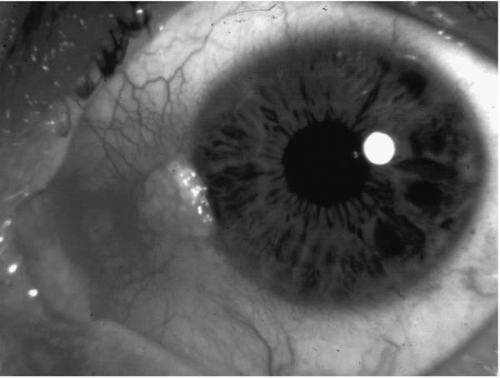Epithelial Tumors Involving the Ocular Surface
Glenn C. Cockerham
Kimberly P. Cockerham
The ocular surface, consisting of the cornea, limbus, conjunctiva and caruncle, is covered by a continuous lining of nonkeratinizing epithelium. The epithelial phenotype varies according to location and function. Bulbar and tarsal conjunctiva contains columnar epithelium with mucus-producing goblet cells, whereas squamous epithelium covers the corneal surface. Epithelial stem cells found in the crypts of Vogt at the corneal limbus proliferate rapidly and are responsible for a large percentage of squamous neoplasia.
Abnormal cellular differentiation may lead to nonspecific changes in ocular surface epithelium, as in epithelial tissues elsewhere. Proliferation of normal cells with thickening of the epithelial layer is acanthosis. Hyperkeratosis is the production of surface keratin by normally nonkeratinizing cornea or conjunctiva. Keratinized epithelium has a crusty white surface, which is commonly known as leukoplakia. Dyskeratosis is the histologic presence of keratin deeper within the epithelium. All of the processes above may be found in benign as well as malignant tumors. Dysplasia is loss of cellular differentiation, manifest by abnormal size and shape of epithelial cells and nuclei. Biopsy with histopathologic examination is required for definitive diagnosis of suspicious epithelial lesions.
HEREDITARY BENIGN INTRAEPITHELIAL DYSKERATOSIS
Hereditary benign intraepithelial dyskeratosis (HBID) is an inherited disorder of epithelial maturation of the oral mucosa and bulbar conjunctiva. Autosomal-dominant transmission with high penetrance has been reported (1). HBID affects a population of triracial heritage (African, native American, and Caucasian) located in northeastern North Carolina in Halifax and Washington counties, and therefore known as Haliwa Indians. A family with identical phenotype but no known relationship to Haliwa Indians has also been described (2).
Dilated superficial vessels are associated with elevated keratotic plaques in the nasal and temporal perilimbal regions of the bulbar conjunctiva (Fig. 41-1). Vision may be affected if plaques affect the central cornea. The chronic conjunctival hyperemia is recognized as the “red eye” in the endemic community (3). HBID may be initially mistaken for limbal vernal keratoconjunctivitis. Tearing and photophobia are common. Oral lesions, varying from spongy areas to thick plaques, have been found in all cases. No malignant transformation of ocular or oral lesions has been reported (4).
Pathologic examination reveals the benign nature of the lesion. Acanthosis and hyperkeratosis are seen, as well as a characteristic inclusion of keratin within individual cells (dyskeratosis). No cellular atypia is present. Treatment consists of ocular lubrication for mild irritation. Topical corticosteroids may be helpful for exacerbations of inflammation and irritation. Lesions will recur after excision, but removal of plaques affecting vision is helpful (5).
SQUAMOUS PAPILLOMAS
Squamous papillomas are benign proliferations of conjunctival surface epithelium. Conjunctival papillomas may occur at any age, but are most common between the ages of 20 and 39 years (6). Papilloma accounted for 7% of 302 epibulbar tumors in children under age 15 (7). The predominant growth pattern is exophytic and may be exuberant, involving a large portion of the ocular surface (Fig. 41-2). Limbal papillomas may extend into corneal epithelium (8). Inverted papillomas of the conjunctiva, with downward growth, are rare (9). Pedunculated multiple papillomas are usually of viral origin, whereas sessile papillomatous lesions in elderly patients may represent an intraepithelial neoplasm.
Human papilloma virus (HPV) is an oncogenic double-stranded DNA papovirus implicated in verrucae (skin warts), condylomata acuminata (venereal warts) and mucocutaneous papillomas. Conjunctival inoculation with HPV may occur with delivery through an infected birth canal, through sexual contact, or by autoinoculation (10). Sjo and colleagues (6) identified the DNA of HPV type 6 or 11 in over 80% of
conjunctival papilloma samples tested by polymerase chain reaction (PCR). Eng and colleagues (11) demonstrated HPV 6 or 11 in 58% of conjunctival papillomas.
conjunctival papilloma samples tested by polymerase chain reaction (PCR). Eng and colleagues (11) demonstrated HPV 6 or 11 in 58% of conjunctival papillomas.
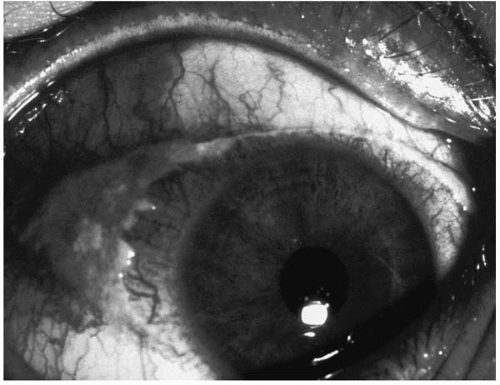 FIGURE 41-1. Hereditary benign intraepithelial dyskeratosis (HBID). Raised, vascular hyperkeratotic lesion is located on the temporal interpalpebral conjunctiva. (Courtesy of the Armed Forces Institute of Pathology).(see color image) |
Standard therapy of papillomas consists of surgical excision, with cautery or cryotherapy of the base (12,13). Despite thorough destruction of the lesions and adjacent epithelium, papillomas may recur. Vaporization of lesions with a carbon dioxide laser may be beneficial in the treatment of recurrent papillomas (14). Mitomycin-C 0.3 mg/mL on a cellulose sponge applied to the epithelial defect for 3 minutes after excision has proven helpful in preventing recurrence (15). Topical mitomycin C 0.02% applied four times daily for 2 weeks, beginning 1 week after excision, has also been employed successfully in the management of recurrent papillomas (16). Caution should be employed in treating an area of conjunctival excision with topical mitomycin C, because of reports of scleral thinning and perforation in bare sclera pterygium excision treated with mitomycin C (17).
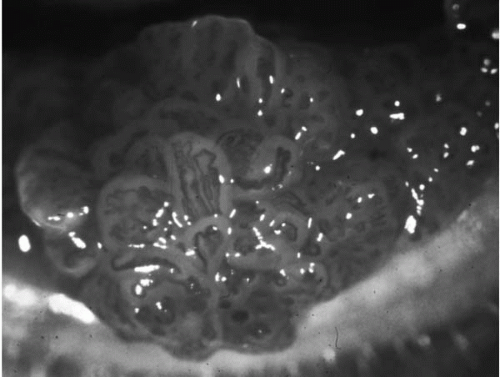 FIGURE 41-2. Squamous papilloma. Exuberant proliferation of benign conjunctiva is present in the inferior fornix.(see color image) |
Intramuscular interferon-alfa-N1 given daily for 1 month suppressed the recurrence of papillomas after excision, but was not felt to be curative (18). Topical interferon-alfa-2b 1 million units/mL four times daily has resulted in resolution of papillomas by 3 months without surgical excision (19). Four months of oral therapy with liquid cimetidine 30/mg/kg was successful in resolving recalcitrant, diffuse conjunctival papillomatosis in a child (20). Cimetidine is a histamine-2 receptor antagonist, which also has immunomodulation properties, such as inhibition of suppressor T-cell function.
Microscopically, papillomas consist of multiple branching fronds, emanating from a pedunculated base. Acanthotic nonkeratinizing epithelium surrounds a vascularized core of connective tissue, often with light inflammation. Koilocytes, viral inclusions within the epithelium, are a variable finding within papillomas.
CONJUNCTIVAL-INTRAEPITHELIAL NEOPLASIA (CIN) AND SQUAMOUS CELL CARCINOMA
Epithelial neoplasia of the ocular surface is considered a disease complex, comprising a spectrum of changes originating within the epithelial layers. Previously used terms for this condition include Bowen’s disease and ocular surface squamous neoplasia. Pizzarello and Jakobiec suggested the currently used term, conjunctival intraepithelial neoplasia (CIN), similar to cervical intraepithelial neoplasia used in gynecologic pathology (21). Conjunctival-corneal intraepithelial dysplasia (CCIN) is appropriate if the cornea is also involved (22). The earliest change is dysplasia, confined by the underlying epithelial basement membrane. Increasing degrees of dysplasia occur if the process is not arrested, culminating in transgression of the basement membrane with invasion of the underlying space and structures. This invasion of subjacent tissue is the hallmark of squamous cell carcinoma (Fig. 41-3). Histologic examination is required for definitive diagnosis.
Incidence and Etiology
CIN occurs primarily in elderly, lightly-complexioned men with extensive actinic exposure. In a review of 26 cases of squamous cell carcinoma of the conjunctiva in an Australian population, 77% of the patients were male and 69% were older than 60 years of age (23). The incidence of squamous cell carcinoma of the eye has been calculated to increase 49% for each 10-degree decrease in latitude (24). The incidence of CIN in African tribal peoples in Uganda was 0.13 cases/100,000 between 1961 and 1966. In the predominantly
Caucasian population of Australia, the incidence of CIN in the period 1980 to 1989 was 1.9/100,000 (21). Previous history of skin cancer is a positive prognosticator for CIN. In addition to ultraviolet light, other reported risk factors include previous history of skin cancer, smoking, ocular trauma, and petroleum derivative exposure (25, 26).
Caucasian population of Australia, the incidence of CIN in the period 1980 to 1989 was 1.9/100,000 (21). Previous history of skin cancer is a positive prognosticator for CIN. In addition to ultraviolet light, other reported risk factors include previous history of skin cancer, smoking, ocular trauma, and petroleum derivative exposure (25, 26).
 FIGURE 41-3. Conjunctival epithelium. Diagram demonstrates (A) normal epithelium, (B) dysplasia confined to the epithelium, and (C) squamous cell carcinoma, with invasion of the underlying tissue. |
Human papilloma virus (HPV), especially types 16 and 18, has been identified in conjunctival epithelial neoplasia by immunohistochemical and molecular analysis (27, 28, 29). However, the role of HPV in the etiology of CIN remains unclear. Karcioglu and Issa (30) identified the DNA of HPV types 16 and 18 in 57% of CIN specimens, 55% of invasive squamous cell carcinoma of the conjunctiva, and in 32% of normal conjunctiva obtained during cataract surgery. Eng and colleagues (11) were unable to demonstrate the DNA of HPV 16 or 18 in any of 20 specimens of CIN.
Atypical, rapidly progressive CIN occurring in younger patients has been associated with human immunodeficiency virus (HIV) (31, 32, 33). CIN has been reported in younger organ transplant patients treated with long-term cyclosporine therapy (34). Xeroderma pigmentosum is an autosomal-recessive disorder characterized by inadequate repair of DNA damage caused by ultraviolet radiation. Affected patients are predisposed to epithelial cancers, including those of the conjunctiva and cornea (35).
The limbus is the transitional zone from columnar conjunctival epithelium to stratified squamous corneal epithelium. Within its crypts of Vogt are the progenitor cells of the corneal epithelium, the limbal stem cells. This area is analogous to the uterine cervix. Similar to cervical tissue, the corneal limbus is the site of origin for the vast majority of dysplastic and neoplastic changes of the ocular surface.
Clinical Presentation
The patient with CIN most commonly presents with ocular irritation or complaints of redness or a “growth on the eye.” Vision is typically not affected. Lesions are readily accessible to slit-lamp biomicroscopy; however, differentiation of benign from malignant surface tumors is difficult, even for the experienced observer. Examination may reveal a vascular limbal mass, usually located within the interpalpebral area. The affected area is thickened, and may appear gelatinous or velvety. Gelatinous thickening, with discrete superficial blood vessels, is most common (Fig. 41-4) (21).
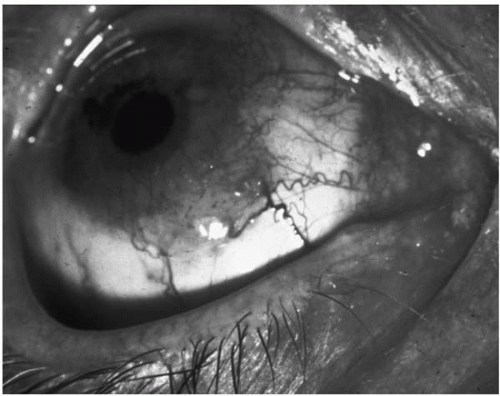 FIGURE 41-4. Conjunctival intraepithelial neoplasia (CIN). A thickened, gelatinous lesion with increased vascularity is noted at the limbus. (Courtesy of the Armed Forces Institute of Pathology).(see color image) |
CIN may present as diffuse chronic conjunctivitis with minimal thickening (36, 37). Other less common presentations include necrotizing scleritis with scleral perforation (38) or sclerokeratitis, described as focal corneal or scleral thinning and inflammation without a tumor mass (39). Sclerokeratitis may mimic interstitial keratitis or Mooren’s ulceration. Biopsy should be performed in cases of atypical or chronic scleritis or conjunctivitis unresponsive to standard therapy.
Hyperkeratosis is a feature of CIN and may manifest as a white surface plaque, or leukoplakia (Fig. 41-5). Leukoplakia has no diagnostic significance, and is not helpful in distinguishing benign from malignant tumors. Neoplastic cells may invade corneal epithelium, usually as a continuation of limbal CIN. Isolated squamous cell carcinoma of the central cornea without limbal attachment has been reported (40). It is possible that neoplastic cells in these cases originated at the limbus and migrated centrally. Affected epithelium is translucently gray, with sharply demarcated borders (Fig. 41-6). Finger-like extensions, as well as isolated islands may be found on the leading edge. The epithelium within the lesion is thickened, and blood vessels may be present, especially near the limbus. Spontaneous regression of the corneal process has been reported (22).
Squamous cell carcinoma is a progression of dysplasia, with invasion through the basement membrane of the epithelium.
Marked thickening of a limbal lesion, as well as fixation of the mass to underlying tissue, suggests squamous cell carcinoma (Fig. 41-7).
Marked thickening of a limbal lesion, as well as fixation of the mass to underlying tissue, suggests squamous cell carcinoma (Fig. 41-7).
The study of representative cells from a lesion may yield helpful diagnostic information. In both exfoliative cytology and impression cytology, superficial cells are removed from a suspicious area, fixed and stained with a Papanicolaou technique, and studied by a cytopathologist. In exfoliative cytology cells are removed with a sterile platinum spatula, whereas in impression cytology cells are retained on cellulose acetate paper strips, which are pressed against the area in question. Cells are graded on degree of atypia, including size, shape, nuclear and nucleolar characteristics, and mitotic figures. Cytology has been reported to be positive in 77% of biopsy-proven cases (41).
 FIGURE 41-6. CIN. Extension of translucent dysplastic epithelium into the cornea. This degree of limbal involvement causes limbal stem cell deficiency. (Courtesy of the Armed Forces Institute of Pathology).(see color image) |
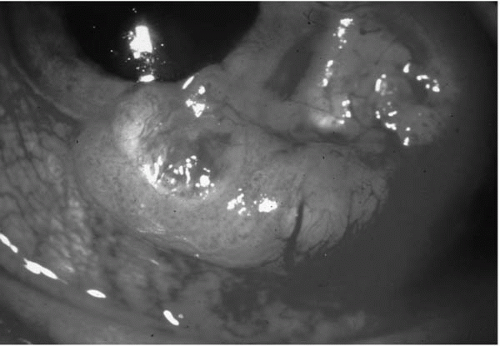 FIGURE 41-7. Squamous cell carcinoma. A markedly thickened conjunctival tumor originates at the limbus. (Courtesy of the Armed Forces Institute of Pathology).(see color image) |
Differential Diagnosis
Benign epithelial lesion-associated thickening and surface keratin are often clinically indistinguishable from CIN. Irritation caused by stromal inflammation or by pinguecula or pterygia may lead to pseudoepitheliomatous hyperplasia, with thickening of the epithelium and leukoplakia. This appearance suggests a neoplastic process. Biopsy will reveal the benign histologic appearance of acanthosis and hyperkeratosis without dysplasia. Simple excision is curative.
Actinic keratosis of the ocular surface is felt to be related to ultraviolet radiation. As such, these lesions occur in older, lightly complexioned people with extensive previous exposure to sunlight, the same population at higher risk for CIN. Thickening of the lesion with hyperkeratosis is usually present. Histopathologic examination may demonstrate a spectrum of change, from mild acanthosis with hyperkeratosis and inflammation, to marked acanthosis with cellular pleomorphism.
Benign conjunctival papillomas, chronic conjunctivitis, and inflammation of a pingueculum or pterygium may resemble CIN.
Pathology
Histologic examination is required for definitive diagnosis. If the lesion is small, excisional biopsy with removal of the entire mass is performed. Incisional biopsy of the most atypical area is performed for larger lesions. Routine staining with hematoxylin-eosin and periodic acid-Schiff is sufficient for the diagnosis of most CIN lesions. Biopsy allows determination of the depth of the lesion, as well as whether the margins are free of tumor. The transition from normal to abnormal epithelium is relatively abrupt (Fig. 41-8).
Specimens are graded on location and degree of atypia. Full-thickness dysplasia corresponds to carcinoma-in-situ. Extension of tumor cells into the subepithelial space (substantia propria, sclera, or cornea) constitutes squamous cell carcinoma. Advanced tumors may extend into ciliary body, iris, and trabecular meshwork.
Specimens are graded on location and degree of atypia. Full-thickness dysplasia corresponds to carcinoma-in-situ. Extension of tumor cells into the subepithelial space (substantia propria, sclera, or cornea) constitutes squamous cell carcinoma. Advanced tumors may extend into ciliary body, iris, and trabecular meshwork.
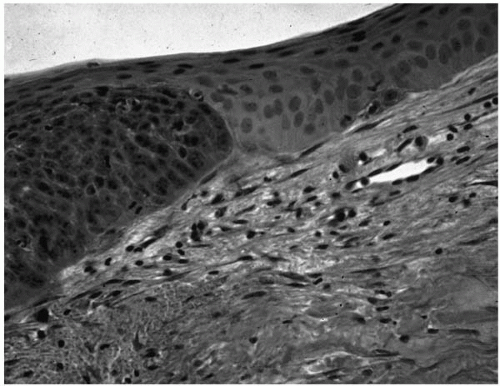 FIGURE 41-8. CIN. Full-thickness intraepithelial dysplasia is seen. Note the abrupt transition between dysplastic and normal epithelium. (Courtesy of the Armed Forces Institute of Pathology). |
Mucoepidermoid carcinoma is unusual in the conjunctiva. Clinically it is indistinguishable from CIN. Histopathologic examination demonstrates epidermoid cells and mucus-secreting cells. Special stains for mucin, such as Alcian blue or mucicarmine are helpful in the diagnosis. Because mucoepidermoid carcinoma of the conjunctiva tends to be more locally aggressive than CIN, this diagnosis should prompt heightened vigilance for invasion and recurrence (42).
Spindle cell carcinoma is another aggressive variant of conjunctival squamous cell carcinoma that may arise on the ocular surface. Clinical differentiation of this tumor from other forms of CIN is not possible. Pathologically, pleomorphic spindle cells are seen, sometimes arranged in fascicles. Morphologically, it may be difficult to distinguish spindle cell carcinoma from other spindle cell tumors, such as spindle cell melanoma, leiomyoma, rhabdomyosarcoma, or other sarcomas. Immunohistochemical analysis with cytokeratin stains will demonstrate the epithelial origin of spindle cell carcinoma. Transmission electron microscopy may be helpful in difficult cases (43,44).
Treatment
Surgical excision of the suspicious area is the standard approach to therapy, especially if the entire lesion can be removed in toto. Staining of the tumor with rose bengal will highlight abnormal epithelium. A wide surgical margin of 2 to 3 mm around the visible tumor is recommended. Frozen section control can assess the lateral surgical margins, but is not helpful with the deep margins.
Stay updated, free articles. Join our Telegram channel

Full access? Get Clinical Tree


